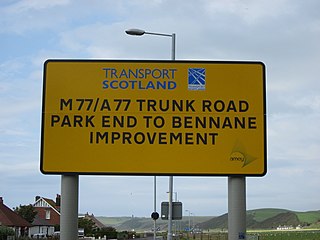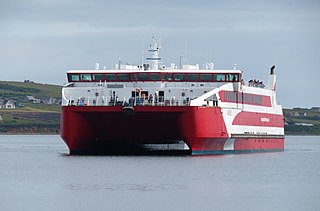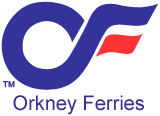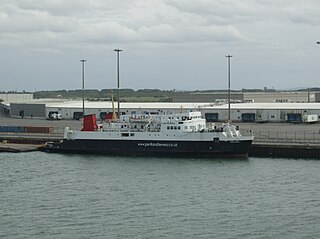Description
The ship, with a length of 112 m (367 ft) and beam 18.5 m (61 ft), measures 8,780 GT. Hamnavoe has a capacity for 600 passengers and 68 cars. [5] Facilities include passenger lounges and bars, a self-service restaurant, a children's playroom, a sun deck and a games room. There are 16 passenger cabins with two or four berths, which are all en suite. There are two specially adapted cabins for the disabled and wheelchair access throughout the ship.
Hamnavoe is powered by twin MaK 9M32C diesels, totalling 8,680 kW (11,640 bhp) and resulting in a service speed of 19 knots (35 km/h; 22 mph).

The Pentland Firth is a strait which separates the Orkney Islands from Caithness in the north of Scotland. Despite the name, it is not a firth.

Caledonian MacBrayne, usually shortened to CalMac, is the major operator of passenger and vehicle ferries, and ferry services, between the mainland of Scotland and 22 of the major islands on Scotland's west coast. Since 2006, the company's official name has been CalMac Ferries Ltd, although it still operates as Caledonian MacBrayne. In 2006, it became a subsidiary of holding company David MacBrayne, which is owned by the Scottish Government.

The transport system in Scotland is generally well-developed. The Scottish Parliament has control over most elements of transport policy within Scotland, with the Cabinet Secretary for Transport, Net Zero and Just Transition holding portfolio responsibility within the Scottish Government. Transport Scotland is the Executive Agency responsible for the Scottish transport network.

Scalloway is the largest settlement on the west coast of the Mainland, the largest island of the Shetland Islands, Scotland. The village had a population of roughly 900, at the 2011 census. Now a fishing port, until 1708 it was the capital of the Shetland Islands.

Scrabster is a small settlement on Thurso Bay in Caithness on the north coast of Scotland. It is some 1+1⁄2 miles (2.4 km) from Thurso, 22+1⁄2 miles (36.2 km) from Wick, 112 miles (180 km) from Inverness and 271.7 miles (437.2 km) from Edinburgh. Scrabster Harbour is an important port for the Scottish fishing industry.

MV Isle of Lewis is a ro-ro ferry operated by Caledonian MacBrayne between Oban and Castlebay, Barra. Built in 1995, she remains one of only two ships in the CalMac fleet over 100 metres (328 ft) in length; the other, Loch Seaforth, being longer by almost 15 metres.

NorthLink Ferries is an operator of passenger and vehicle ferries, as well as ferry services, between mainland Scotland and the Northern Isles of Orkney and Shetland. Since July 2012, it has been operated by international services company Serco.

The Caledonian MacBrayne fleet is the largest fleet of car and passenger ferries in the United Kingdom, with 34 ferries in operation, 2 on charter and another 6 on order. The company provides lifeline services to 23 islands off the west coast of Scotland, as well as operating routes in the Firth of Clyde.

Gills Bay, which is situated about 3 mi (4.8 km) west of John o' Groats with the community of Gills close by, has one of the longest stretches of low-lying rock coast on the northern shores of Caithness. Its main features are a small harbour and the pier used as the mainland terminal for Pentland Ferries. The harbour shelters some small local boats together with those used for working the sheep on the off lying island of Stroma. In the right sea conditions the area is sometimes used for surfing.

Pentland Ferries is a privately owned, family company which has operated a ferry service between Gills Bay in Caithness, Scotland and St Margaret's Hope on South Ronaldsay in Orkney since May 2001. The company is one of only two major vehicle ferry operators plying within Scotland which are not subsidised by the Scottish Government or local authorities.

Orkney Ferries is a Scottish company operating inter-island ferry services in the Orkney Islands. The company operates ferry services across 15 islands.

MV Loch Shira is a car ferry operating on the Largs to Cumbrae route on the Firth of Clyde in western Scotland. The vessel is operated by Caledonian MacBrayne.

MV Hebridean Isles is a ro-ro vehicle ferry operated by Caledonian MacBrayne on the west coast of Scotland. She was the first MacBrayne vessel to be ordered and built for them outside Scotland and the first to be launched sideways. With bow, stern and side ramps, Hebridean Isles is suitable for all the routes served by the large fleet units. After 15 years crossing the Little Minch on the Uig triangle, she now serves Islay and Colonsay.

MV Orion is a ro-ro passenger and vehicle ferry. Saturn was operated by Caledonian MacBrayne in the Firth of Clyde in Scotland between 1978 and 2011, for the first decade of her career on the Rothesay crossing. Later, she also saw service on the Dunoon and Brodick crossings, as well as on short cruises around the Clyde.

MV Pentalina-B was a ferry which operated on a variety of Scottish routes. Launched in 1970 as MV Iona, she was the first drive-through roll-on/roll-off ferry built for the David MacBrayne fleet. She was the first ship in the company's history to have bridge-controlled engines and geared transmission, rather than direct drive. During her career she inaugurated more endloading linkspans than the rest of the fleet put together. Purchased by Pentland Ferries in 1997, she was renamed MV Pentalina-B and operated across the Pentland Firth until the arrival of their new vessel. In 2009, she was sold to a Cape Verde owner.

MV Hjaltland is a NorthLink Ferries vehicle and passenger ferry based in Aberdeen. She operates the daily service from mainland Scotland to Orkney and Shetland.

MV Hrossey is a NorthLink Ferries vehicle and passenger ferry based in Aberdeen. Along with her sister ship, the MV Hjaltland, she operates a daily ferry service between mainland Scotland and the northern archipelagos of Orkney and Shetland.

David MacBrayne is a limited company owned by the Scottish Government. Formed in 1851 as the private shipping company David Hutcheson & Co. with three partners, David Hutcheson, Alexander Hutcheson and David MacBrayne, it passed in 1878 to David MacBrayne.

Caledonian Maritime Assets Limited owns the ferries, ports, harbours and infrastructure for the ferry services serving the west coast of Scotland, the Firth of Clyde and the Northern Isles.

MV Lochinvar is a pioneering diesel electric hybrid ferry built for Caledonian MacBrayne. Initially, she operated between Tarbert and Portavadie, was moved to the Mallaig to Armadale route in 2016 and currently operates on the Lochaline to Fishnish route. She is one of only three passenger and vehicle roll-on, roll-off ferries in the world to incorporate a low-carbon hybrid system of diesel electric and lithium ion battery power and is the second hybrid ferry commissioned and owned by Caledonian Maritime Assets. The ferries are sea-going and are 43.5 m (143 ft) long, accommodating 150 passengers, 23 cars or two HGVs. The first ferry, MV Hallaig, entered service on the Sconser to Raasay route in October 2013. The third sister ship, MV Catriona, entered service in 2016.





















